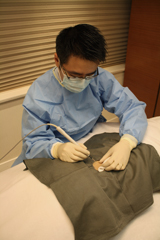 |
Biopsy / Skin Surgery If you have a skin lesion that needs to be removed or sampled to help make a diagnosis, a biopsy may be performed by surgically removing a sample of tissue. The tissue can then be sent to a laboratory for testing. Related Problem(s): Actinic Keratoses Moles Molluscum Contagiosum Skin Cancer Skin Tags Warts Preparing for your operation:Most skin lesions can be removed at the clinic under local anesthesia. Local anesthesia uses medicine to block sensations of pain from a specific location and are usually given by injection into the skin. You will remain awake and conscious during the procedure. Very rarely, a sedative may be administered with the local anaesthetic to help you relax. The operation:The way in which a lesion is removed depends to a large extent on its size and location.
After the operation:You will be advised on how to care for your healing wound before you go home. If required, you may be given a follow-up appointment for wound dressing and the removal of stitches. Simple painkillers such as paracetamol or ibuprofen can be taken as necessary after surgery. Where possible, try to take it easy for the first few days and take special care not to bump or knock the healing wound. If there is a waterproof dressing covering the wound, you may take showers but should avoid splashing directly on the dressing. Bathing and swimming should generally be avoided until the wound has healed and the dressing taken off. Cautions:After having a skin lesion removed, there is a risk that you may develop an infection. An infected wound can take longer to heal and may result in a more noticeable scar. Please contact the clinic if you develop or notice any of the following symptoms:
The removal of skin lesions is a common and generally safe procedure. However, in order to make an informed decision and grant your consent, you need to be aware of the possible side effects and the risks of complication involved in this procedure. Side-effects:These are the unwanted, but mostly temporary effects of successful treatment. You may experience some pain, swelling and bruising of the skin around the wound. The skin wound will usually leave a scar. The size and prominence of the scar typically depends on the amount of skin that is removed. Ask your dermatologists about how much scarring to expect before your treatment. Most scars fade significantly over the first year. Complications:Complications associated with having a skin lesion removed are uncommon, but can include:
|
|
DISCLAIMER: The information contained in this site is strictly intended only for the use of registered patients and is confidential and may be privileged and/or otherwise protected from disclosure. Any unauthorised use, copying, dissemination or any other action taken or otherwise omitted to be taken in reliance upon this information is prohibited.


